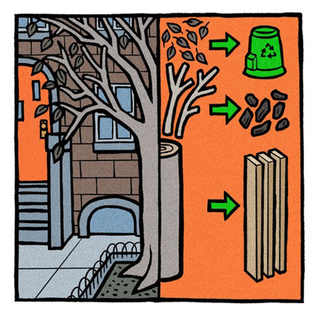
Gregory Nemec
A tree is planted on a city corner. What does it do? It grows. It inhales carbon and gives back oxygen. It scrubs car exhaust from the air and drinks the flooding rains. It silently cools the air. It houses birds and bugs and squirrels.
And then it dies.
What happens to a tree in the city when it dies?
This question, often over- looked, gets its due in a new study published in the journal One Earth. Yuan Yao, an assistant professor at Yale School of the Environment (YSE), with two postdocs from her lab—Kai Lan and Bingquan Zhang—explores how different methods of disposal either contribute to or mitigate climate change at the end of a tree’s life. “Every year there is a lot of urban tree waste generated,” says Lan. “Understanding the potential environmental benefits of utilizing this waste is critical.”
The research looks at ways to dispose of a tree beyond tossing it in a landfill or burning it—two methods that contribute to climate change by releasing greenhouse gases. Cities can, alternatively, create wood chips or commercial lumber from tree trunks; they can compost leaves; they can turn other leftover parts, like branches and needles, into biochar, a carbon-rich material with a range of uses, from water treatment to soil fertilization.
Yao and her colleagues used a tool known as life cycle assessment to determine the environmental effects of mixing different management approaches. What is the environmental outcome if, for instance, everything is sent to landfill? What if, instead, leaves are landfilled but trees are burned to create energy? What if leaves are composted and trees converted to mulch? Across five different scenarios, the researchers looked at contributions to both climate change and eutrophication (meaning an unhealthy overload of nutrients in nearby waterways).
They found that processing the trunks of dead trees into commercial lumber, or converting tree waste into biochar, are the two most environmentally friendly forms of utilization. Composting and mulching are also preferable to either landfill or incineration. Notably, the potential of these approaches varies by city and state, depending on the types of tree waste available.
The climate gains derived from these alternatives are sizable. Urban forest covers roughly 50 million hectares in the United States—about twice the size of Maryland. Converting all these trees, once dead, into something productive could reduce agricultural emissions. Cities tend to conjure the challenge of managing vast quantities of concrete and steel, plastic and paper. But “this study demonstrates the potential benefits of practicing circular economy principles with urban tree waste,” says Lan.
 loading
loading